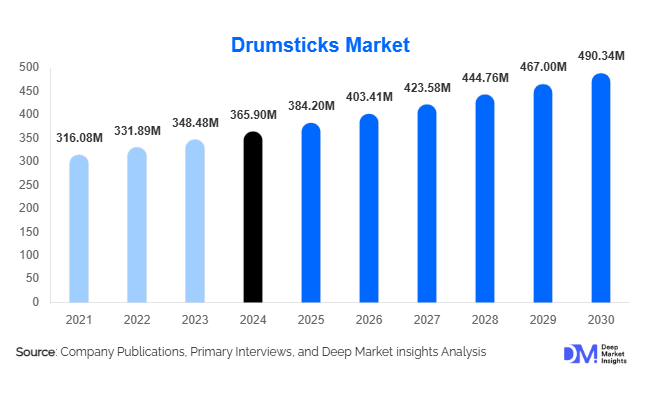Short answer: The drumsticks market is growing steadily, fueled by a mix of rising interest in drumming (especially among younger musicians), the expansion of music education, and the boom of genres like rock, hip-hop, and jazz. From beginners to pros, people are now paying more attention to what they play with not just what they play on. The result? A more competitive and diversified drumstick market than ever before.
The global drumsticks market size was valued at USD 365.9 million in 2024 and is projected to grow from USD 384.20 million in 2025 to reach USD 490.34 million by 2030, growing at a CAGR of 5% during the forecast period (2025-2030). The market is supported by strong demand from the live concert scene and a growing preference for custom drumsticks with enhanced grip, weight balance, and ergonomic features. These innovations cater to both professional drummers and a new wave of online content creators in the music space.
What types of drumsticks are most popular and how do you choose the right ones?
It depends on your style, skill level, and sound preferences.
Not all drumsticks are created equal. What works for a jazz drummer might be completely off for a heavy metal player. Here’s a breakdown of common types:
-
5A – The “goldilocks” stick. Not too heavy, not too light. Great all-rounder.
-
5B – Slightly thicker, heavier. Ideal for rock or louder genres.
-
7A – Thinner, lighter. Perfect for jazz, funk, or younger players.
-
Marching sticks – Heavier and longer for outdoor or corps-style playing.
-
Brushes and rods – Used for softer genres, unplugged sets, or acoustic gigs.
The tip shape (oval, round, acorn) also changes the tone, while the material (wood vs. nylon tip) affects rebound and durability.
Are wooden drumsticks better than synthetic ones?
Not always it’s more about feel, sound, and use case.
Here’s a quick comparison:
| Material | Pros | Cons | Best For |
|---|---|---|---|
| Hickory (wood) | Great balance and shock absorption | Can splinter over time | Most styles – classic choice |
| Maple (wood) | Lighter, faster | Less durable | Jazz, fast playing |
| Oak (wood) | Very durable, heavy | More rebound, less finesse | Rock, metal |
| Carbon fiber/composite | Super long-lasting, consistent | More expensive, less “organic” feel | Touring drummers, practice |
| Nylon tip (hybrid) | More consistent cymbal sound, lasts longer | Less warm tone | Studio use, rock/pop |
If you’re a beginner? Go with hickory 5A sticks they’re the standard starting point for a reason.
Who’s buying drumsticks and is the market growing?
Musicians, yes but also educators, parents, and even collectors.
The drumsticks market is expanding because:
-
More kids are learning drums thanks to school bands, YouTube tutorials, and apps
-
Home recording and jam spaces are more accessible especially post-COVID
-
Drummers are playing across multiple genres requiring different sticks
-
Collectors and fans buy artist series or signature sticks as merch
-
Replacement rate is high sticks break or wear down, even for casual players
As a result, both mainstream brands and niche makers are getting a piece of the pie.
What are the most trusted drumstick brands in 2025?
A few names dominate, but indie and custom makers are rising too.
Top players include:
-
Vic Firth – Industry standard. Wide range, durable, endorsed by top pros.
-
ProMark – Owned by D’Addario. Known for their rebound feel and balance.
-
Zildjian – Famous for cymbals, but their sticks hold their own.
-
Ahead – Makes durable, high-tech aluminum/composite sticks.
-
Meinl Stick & Brush – Gaining popularity for their unique feel.
Meanwhile, custom and boutique brands like Los Cabos, Vater, and Bopworks are carving out loyal followings with handmade or specialty models.
Are expensive drumsticks worth the extra money?
Sometimes especially if you’re breaking cheap ones too often.
Most sticks cost between $9 to $20 per pair, but signature or specialty models can go higher. Here’s when it makes sense to invest:
-
You’re a frequent gigging drummer and need reliable tools
-
You want a specific tone or feel for your studio sessions
-
You’re into marching or orchestral percussion with higher durability needs
-
You’re chasing a specific artist’s playing style
That said, for practice or casual jamming, a mid-range pair from a known brand will do just fine.
What’s the environmental impact of drumsticks and are there eco-friendly options?
Yes and this issue is gaining traction in the community.
Because most drumsticks are made from slow-growing hardwoods, deforestation is a concern. That’s why:
-
Some brands (like Vater and Vic Firth) are sourcing wood responsibly
-
Others are using alternative materials like bamboo, recycled plastics, or carbon fiber
-
Some offer stick recycling programs or produce longer-lasting synthetics
If sustainability matters to you, look for FSC-certified woods or buy from companies with replanting initiatives.
How are online sales and digital content shaping the drumstick market?
Big time because drummers are learning and shopping online more than ever.
Online tutorials, social media, and influencer culture are fueling demand for:
-
Signature sticks from YouTube drummers or touring artists
-
Bundles or practice kits for beginners
-
Niche sticks for specific genres or techniques
-
Unboxing and review videos that influence buying decisions
Plus, direct-to-consumer sales mean smaller brands can compete globally and drummers can try something new with just a click.
Final Thoughts: Is the drumstick market just for pros or is it beginner-friendly too?
Totally beginner-friendly but rich enough for pros to obsess over.
Whether you’re just starting out or refining your sound, the right pair of sticks can make a noticeable difference. They affect how you play, how your drums respond, and even how long you enjoy a session.
In short: Drumsticks aren’t just accessories they’re instruments in their own right.
And as the market grows, players now have more options, more customization, and more ways to express themselves than ever before.

